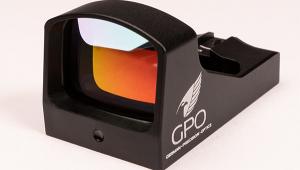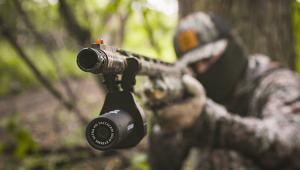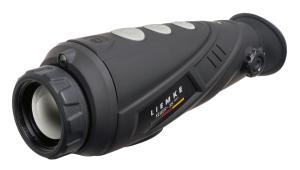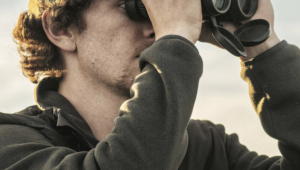10 Tips to Up Your Glassing Game
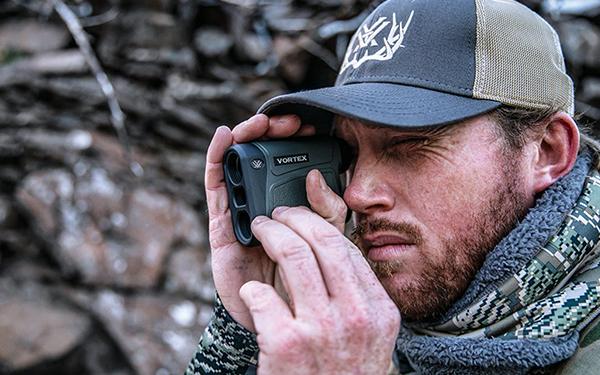
Below are 10 simple tips to educate your customer on how to up their glassing game, and bring more game to the table.
1. Open up: Glass openings from afar and before you enter them. They are great places to spot game, and nothing is more frustrating than spooking your quarry when it’s within striking distance. Game gravitates to open areas for a variety of reasons. An opening can be as big as a clear cut or agriculture field and as small as a meadow in the timber. For a turkey, utilizing these spaces might be food-related, or to strut and display. For a deer, the browse may be lush and diverse.
2. Brace yourself: If you’re not using a tripod, there’s a few things you can do to stabilize binoculars during hand-held glassing sessions. Turning the brim of your ball cap into a hand hold will stabilize your view and help eliminate arm fatigue. Take a seat. This will get you way more stable than standing, as well as gets you in an optimal position to brace your elbows on top of your legs. If terrain or brush dictates standing, tuck your elbows into your chest.
3. Three legs are better: Few things will make you a better ‘glasser’ than a tripod. And if you’re already carrying one for your spotting scope, integrating a binocular tripod-adapter adds virtually zero weight to your kit. A tripod (preferably with a pan-head) better allows you to methodically evaluate expansive country, cuts muscle fatigue considerably, makes spotting subtle movement much easier, and lets you stay on a subject once found.
4. Take what you learned reading - and stop: Ok, not completely. We read left-to-right, so make a point at times to scan from right-to-left. Admittedly, I find this hard to do. It just doesn’t feel natural –that’s why it works. It takes your brain off autopilot and forces you to see terrain and what may be hiding in it differently, with greater attention to detail.
5. We covered reading, so let’s talk math: Your glassing should have an order of operations. Hit high percentage spots first. When you begin glassing, start with spots known to hold game. After that, work from the inside out in hopes of finding animals closer in proximity to your location within shooting range, stalking range, or inclined to spook due to your presence. Early and late in the day when game is likely on the move, it’s good to give the extreme edges of the country you’re glassing a priority look.
6. Use the sun to your advantage: Deer can be shady characters. When it’s hot and the sun is blazing, we seek shade and peel off layers. The game you’re after may be doing the exact same thing. Well, not peeling off layers. If conditions are like this, glass shady spots. Conversely, on cool days, deer may be intentionally capturing the sun’s rays to warm up. Glassing hillsides and faces that get early sun may be the ticket to finding animals looking to heat their mammalian bodies after a cold night. They will also be much easier to spot, as they will likely be standing, moving, and seemingly glowing in the morning sun.
7. In the timber and can’t see more than 100 yards? Perfect: Glassing in the timber or densely vegetated terrain is an under implemented tactic - particularly when “still hunting” and moving at a snail’s pace. (Want to learn more about still hunting? Check out this 10-Minute Talk.) You will be able to spot minute details and pieces of game standing or bedded. What may look like a wall of trees and brush with the naked eye, could become a buck or bull in a tight shooting lane the second you put your binos up.
8. Get low: Wait, all I ever hear is I need to get to a high point to glass? That is a damn good tip, but in some scenarios, losing a bit of elevation to see over the roll of a hill allows you to spot game right under your nose. These animals might not even be far off the beaten path, but feel secure, in their open, out of sight hidey-hole because no one ever bothers them. So, go bother them. Inevitably, you can’t see everything from a single location. Even minor changes in perspective will reveal country worth a hard look.
9. Comfort is key: A glassing pad for your hindquarters will protect you from sharp rocks, sticks, cactus, keep you dry, and insulate you from the ground. Quietly clearing out an area of debris can help if you don’t have a pad – but be careful. Depending on where you’re hunting, there could be undesirable critters like ants, spiders, scorpions, and snakes living under the rocks, logs, and bark you disturb.
10. Protect yourself: When glassing, you can spend hours in the same spot – particularly if you are keeping tabs on an animal your hunting partner is making a move on – all the while that glorious ball of fire and gas beats down on your skin with reckless abandon. Hopefully in this scenario, you have a lightweight hoodie you can pull over your head.
- Log in or register to post comments



